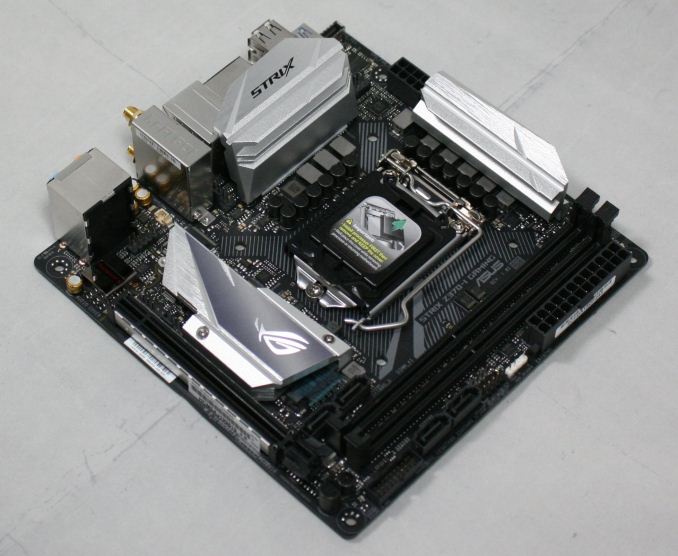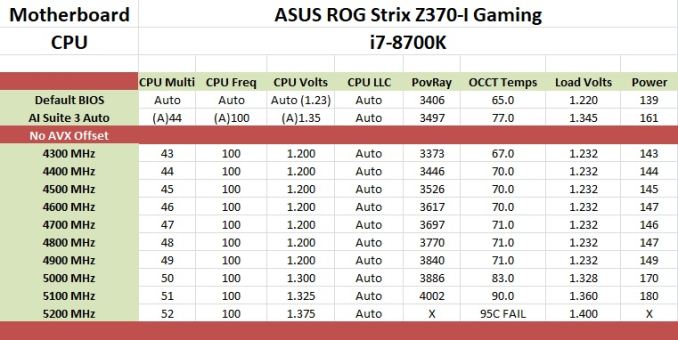The ASUS Z370-I Gaming Review: Mini-Me Mega Motherboard
by Joe Shields on May 21, 2018 11:00 AM EST- Posted in
- Motherboards
- Intel
- Mini ITX
- Asus
- Coffee Lake
- Z370
- Z370-I Gaming

The ASUS ROG Strix Z370-I Gaming is one of the major Mini-ITX options for Intel's latest Coffee Lake processors. ASUS has a good history of building substantial Mini-ITX offerings, particularly with the ROG Impact line, however it is the Z-series mainstream Mini-ITX models that are the more cost effective option. For this generation, ASUS is combining dual M.2 slots, USB 3.1, EMI shielded audio and Wi-Fi on this small square platform. In this review we put it through its paces.
AnandTech Intel Z370 Motherboard and CPU Coverage
- The Anandtech Coffee Lake Review: Initial Numbers on the Core i7-8700K and Core i5-8400
- Analyzing Z370 for Intel's 8th Generation Coffee Lake: A Quick Look at 50+ Motherboards
- ($397) The ASUS ROG Maximus X Apex Review [LINK]
- ($250) The NZXT N7 Z370 Review [LINK]
- ($191) The SuperO C7Z370-CG-IW Review [LINK]
- ($180) The ASUS Z370-I Gaming (this review)
- ($150) The GIGABYTE Z370 Ultra Gaming Review [planned]
- ($144) The GIGABYTE Z370 Gaming WiFi Review [planned]
ASUS ROG Strix Z370-I Gaming Overview
The Mini-ITX space of the Z370 platform will typically attract users who want a powerful PC in a small package - a build will use a Z-chipset who also want to take advantage of some of the Z-exclusive features, otherwise the H-series is usually more cost effective. These builds are high-performance: almost going up to X299, but with fewer cores and higher frequency, or exchanging this for a quieter system.
Board partners take notice of the markets, and each of the four major brands have at least one Mini-ITX offering. Potential buyers are looking for a combination of feature set, appearance, and performance, in order to choose the right board for their needs. The ASUS ROG Strix Z370-I Gaming it built to support the flagship i7-8700K processor (including overclocking), has multiple M.2 slots, Wi-Fi, RGB LEDs, and delivers it in a 17cm square package.
The Strix Z370-I Gaming performed admirably in all our tests scoring as good as any other motherboard in the CPU/GPU performance tests. As tested, the BIOS on this board comes with multi-core enhancement enabled out of the box, in a similar fashion to the others we have tested so far. As a result the system ends up running all cores at 4.3 GHz. For our system tests, the biggest win was in the boot time - as seen in older platforms, ASUS has the fastest booting board we have tested so far. The small board can do more than just boot quickly, however. In overclocking, we saw some impressive numbers.
In our overclocking testing, as shown in the table above, the ASUS Z370-I Gaming is a capable overclocker, taking our i7-8700K to 5.1 GHz stable. The limiting factor here was our CPU temperatures, as the voltage was only slowly increasing still at 5.1 GHz. For automatic overclocking, the 5-Way Optimization process raised the all core boost to 4.7 GHz but added a -3 AVX offset (100 MHz over stock). Up to four cores were set for 5 GHz, which was a 300MHz improvement over its single-core boost of 4.7 GHz. The power delivery heatsinks, though not large, managed the heat loads without issue. While overclocking may not be a primary focus of a Mini-ITX sized motherboard, the Z370-I Gaming handled it with grace.
For onboard features, the board manages to squeeze two M.2 slots in its small amount of real estate. The primary slot is located on the front of the board and shares a heatsink with the chipset. The other M.2 is on the rear, rather than a vertical M.2 slot which ASUS does on its larger motherboards. In addition for storage, the board has four SATA ports vertically oriented around the DRAM slots. For networking, ASUS chose an all Intel setup in the I219-V GbE and 802.11ac AC-8265 for Wi-Fi.
The back panel IO gives users several USB ports - four USB 2.0, and four USB 3.0 - it is worth nothing that the Type-C connector isn't USB 3.1 (10 Gbps), but the board does have an onboard header for USB 3.1 though. Also on the back panel are Displayport and HDMI video outputs for using the integrated GPU. The audio stack uses an upgraded Realtek ALC1220A solution, has five output jacks, and a SPDIF out as well.
Pricing on the Strix Z370-I Gaming comes in at $179 at Newegg. This price point puts it in the same price bracket as the MSI Z370-I Gaming Pro Carbon AC ($174), ASRock Fatal1ty Z370 Gaming-ITX/ac ($180), SuperO C7Z370-CG-IW ($187), with GIGABYTE's Z370N WiFi ($152) costing almost $30 less.
ASUS Z370 Strategy
ASUS brings a number of Z370 motherboards to the table ranging from the Mini-ITX Z370-I Gaming to the flagship Maximus X Formula. The Republic of Gamers boards consisting of the Maximus and Strix series are most of the lineup, with the TUF and Prime lineups each having two boards. Prices range from $130 (Newegg) TUF-Plus for entry-level up to the flagship ROG Maximus X Formula at $441 (Amazon). It's a pretty wide price range with boards of all shapes, sizes, sizes and included features.
| ASUS' Z370 Motherboard Lineup | |||
| AnandTech Review |
Amazon | Newegg | |
| ROG Maximus X Formula | $350 | $350 | |
| ROG Maximus X Apex | LINK | $318^ | $318 |
| ROG Maximus X Code | $279 | $280 | |
| ROG Maximus X Hero Wi-Fi AC | $260 | $260 | |
| ROG Maximus X Hero | - | $241 | |
| ROG Strix Z370-F Gaming | $202^ | $180 | |
| ROG Strix Z370-E Gaming | $187 | $200 | |
| ROG Strix Z370-G Gaming | $196 | $208 | |
| ROG Strix Z370-H Gaming | $156 | $156 | |
| ROG Strix Z370-I Gaming | [this review...] | $201 | $254 |
| TUF Z370-Pro Gaming | $152 | $151 | |
| TUF Z370-Plus Gaming | $156 | $125 | |
| Prime Z370-A | $160 | $164 | |
| Prime Z370-P | $130 | $130 | |
^ - 3rd party seller
Pages in This Review
- Overview
- Visual Inspection
- BIOS and Software
- Board Features
- Benchmark Overview
- System Performance
- CPU Performance
- Gaming Performance
- Overclocking with the i7-8700K
- Conclusions













37 Comments
View All Comments
PeachNCream - Monday, May 21, 2018 - link
Benchmark consistency is important. The same components are used with the exception of the motherboard being reviewed so that the only variable that changes from one review to the next is the motherboard itself. Results can then be reliably compared with previous and future reviews and useful conclusions can be reached about the differences in performance.TerraEnvy - Wednesday, August 1, 2018 - link
Depends on the Case.My Mini-IX Build can in fact support many things.
I am running a gtx 1080 TI in my mini-ITX. So it really just depends on case design.
RVZ03B MINI-ITX Case is designed specifically for a gaming build and as such can fit many things in it, mind you its a tight fit, that many other cases can not handle, but is definitely possible to do these things if you look around enough.
jordanclock - Monday, May 21, 2018 - link
Or you get some water cooling and keep your mini ITX case without sacrificing thermal performance.1_rick - Monday, May 21, 2018 - link
"going the route of smaller Mini-Itx cases is necessary which means a restriction on size of cooler that can be used."I put a 240mm rad in a Mini-ITX case, cooling an overclocked Ryzen.
TEAMSWITCHER - Monday, May 21, 2018 - link
Agreed. A modern MicroATX case is only slightly bigger and eliminates all the compromises of the mini-itx form factor.StevoLincolnite - Monday, May 21, 2018 - link
Ambients usually exceed 50'C (122F) here at least once every summer. 40'C is a cake walk.My LGA2011+3930K rig is still going strong though, with the price of Ram and GPU's, I don't see the point in upgrading right now? The bang for buck just doesn't seem to be there.
808Hilo - Tuesday, May 22, 2018 - link
Quite the contrary my friend. The dissipation is as much as a bigger board. Its easier to cool because the fan stream in a mitx case is acting more like a heattube. Using a board as a heatsink is not such a great idea. My 240 Air is cooling a watercooled 1800x, 32GB Ram and 1080 very well in my hot climate.imaheadcase - Tuesday, May 22, 2018 - link
Huh? You can say that about any electronic equipment though..Samus - Thursday, May 24, 2018 - link
This comment is ridiculous. Cooling compromises? That is entirely dependent on the case, not the motherboard.Most of the chips used in this board, even overclocked, will never exceed 100w power draw. If you were commenting on an x299 ITX platform I'd half agree with you because the compromises are vast, but for Z370?
I'm still running an Asrock H87M-ITX on a severely overclocked i5-4690K (4.6GHz) on water cooling with a 120x40mm radiator in a Silverstone FT03-Mini, not to mention the GTX970 with a blower. System pulls over 400w under load (2xHDD's and an SSD don't help) and the overall footprint is just over ONE cubic foot. Never had any cooling issues.
bolkhov - Monday, May 21, 2018 - link
"is one of two boards of its size which have two M.2 slots (GIGABYTE Z370N WiFi is the other)" --Joe, doesn't Supermicro C7Z370-CG-IW have two M.2s in a similar configuration (on both sides of PCB)?